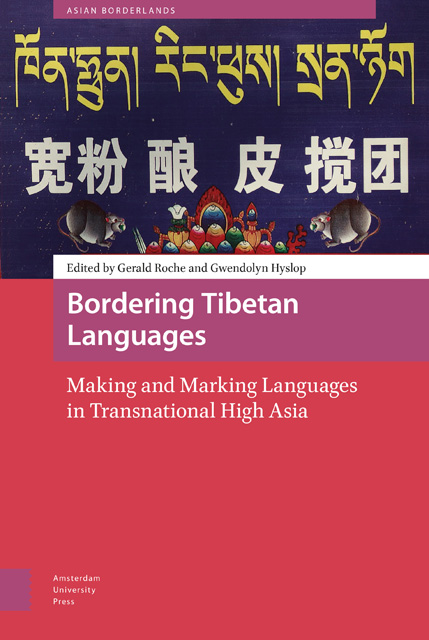Book contents
- Frontmatter
- Table of Contents
- Acknowledgements
- About the Cover Image
- 1 Introduction: Bordering Tibetan Languages: Making and Marking Languages in Transnational High Asia
- 2 Playing with Language Boundaries: Heteroglot Standard Language Ideology and Linguistic Belonging among Amdo Children
- 3 The Role of Classical Tibetan (Chöke) on the Development of Kurtöp, a Language of Bhutan
- 4 Reimagining Rongring without Tibetan Buddhist Influence
- 5 Glottonyms, Identity, and Language Recognition in the Eastern Tibetosphere
- 6 On the Yak Horns of a Dilemma: Diverging Standards in Diaspora Tibetan
- 7 Changing Identity and Linguistic Practices in Nubri: Veiled Language Endangerment in the Nepalese Tibetosphere
- 8 Borderline Dominance: Transnational Tibetan Language Politics in the Himalayas
- 9 Borders: In Conclusion
- Tibetan Language Summaries
- Asian Borderlands
- Index
3 - The Role of Classical Tibetan (Chöke) on the Development of Kurtöp, a Language of Bhutan
Published online by Cambridge University Press: 24 November 2022
- Frontmatter
- Table of Contents
- Acknowledgements
- About the Cover Image
- 1 Introduction: Bordering Tibetan Languages: Making and Marking Languages in Transnational High Asia
- 2 Playing with Language Boundaries: Heteroglot Standard Language Ideology and Linguistic Belonging among Amdo Children
- 3 The Role of Classical Tibetan (Chöke) on the Development of Kurtöp, a Language of Bhutan
- 4 Reimagining Rongring without Tibetan Buddhist Influence
- 5 Glottonyms, Identity, and Language Recognition in the Eastern Tibetosphere
- 6 On the Yak Horns of a Dilemma: Diverging Standards in Diaspora Tibetan
- 7 Changing Identity and Linguistic Practices in Nubri: Veiled Language Endangerment in the Nepalese Tibetosphere
- 8 Borderline Dominance: Transnational Tibetan Language Politics in the Himalayas
- 9 Borders: In Conclusion
- Tibetan Language Summaries
- Asian Borderlands
- Index
Summary
Abstract
Kurtöp displays a special relationship with Classical Tibetan. Although Kurtöp and its sister languages look surprisingly similar to other Tibetan languages, linguists can show even with core data that Kurtöp cannot be a direct descendant of Old Tibetan. The aim in this article is to use the comparative method to reconstruct aspects of the language to Proto East Bodish – the parent language to Kurtöp and other East Bodish languages –and then compare the reconstructions with Written Tibetan as a way to infer influence from Classical Tibetan on Kurtöp. I will show that the influence has been pervasive; although Kurtöp is demonstrably East Bodish (and not Tibetic), lexicon, grammar, and phonology have all been shaped by this liturgical language. In other words, language change and language contact through time can be examined through a lens of linguistic force, resulting in blurred borders.
Keywords: Kurtöp, East Bodish, Bhutan, Classical Tibetan, language change, areal influence
Introduction
The languages of Bhutan are often assumed to be Tibetan dialects, perhaps due to some of the apparent cultural similarities with Tibet and the fact that a version of the Tibetan writing system is employed to represent Bhutan's national language, Dzongkha. Buddhism still operates as a National Religion, with a majority of the country's inhabitants self-identifying as practitioners of various streams of the religion. This religion is also directly linked to Tibetan through the writing system. Classical Tibetan, called Chöke in Bhutan, is the liturgical language of the various forms of Bhutanese Buddhism and still enjoys a very high level of prestige in the country. As such, Chöke extends pressure on the modern languages, and has likely been doing so for over one millennium, since the introduction of Buddhism into Bhutan. In this way, one can see Chöke is a language of influence, crossing borders of language, time, and geopolitical space, to change and shape other modern languages.
Despite a modern perception that Bhutanese ‘language’ might be synonymous with ‘Tibetan,’ Bhutan is actually home to 19 distinct Tibeto-Burman languages (van Driem 1998). Many of these languages are identified as occupying an unknown position within Tibeto-Burman; these include Tshangla, Black Mountain Mönpa, Lhokpu and Gongduk.
- Type
- Chapter
- Information
- Bordering Tibetan LanguagesMaking and Marking Languages in Transnational High Asia, pp. 53 - 82Publisher: Amsterdam University PressPrint publication year: 2022



